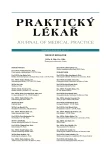Possibilities of use of canistherapy in prevention and treatment
Authors:
J. Malinčíková 1,2; V. Talafa 1; J. Pudich 1; R. Tichá 1
Authors‘ workplace:
Klinika Tělovýchovného lékařství a kardiovaskulární rehabilitace FN a LF UP v Olomouci, Přednostka: doc. MUDr. Eliška Sovová, Ph. D., MBA
1; Centrum výuky odborných předmětů, FZV UP v Olomouci, Vedoucí: Mgr. Věra Vránová, Ph. D.
2
Published in:
Prakt. Lék. 2012; 92(5): 284-286
Category:
Of different specialties
Overview
The aim of this paper is to inform about a possibility of Animal Assisted Therapy made with dogs – canistherapy in prevention and therapy of various diseases. The work covers the description and definition of canistherapy methods and forms. Canistherapy influences positively in particular the psychic and social, but also the physical side. Important effects include e.g. activation, stimulation, motivation, delightful emotional experience, joy, relaxation, distraction from own problems, communication facilitation, psycho-social support, relief, blood pressure drop, mood improvement etc. The canistherapy take a part as a form of supporting rehabilitation. As a physical activity is an important part of cardiovascular prevention and rehabilitation.
Key words:
Animal Assisted Therapy, dog, canistherapy, prevention, treatment
Sources
1. Čajka, V., Sovová, E., Pastucha, D., a kol. Výskyt rizikových faktorů kardiovaskulárních onemocnění u lidí cvičících jógu ve srovnání s běžnou populací. Prakt. Lék. 2012, 92(1), s. 41–44.
2. EU Sport Ministers. EU physical activity guidelines (2008). Recommended policy actions in support of health-enhancing physical activity [on-line]. Dostupný na: http://ec.europa.eu/sport/library/ doc/c1/pa_guidelines_4th_consolidated_draft_en.pdf [cit. 30. 4. 2012].
3. Fine, A. H. Handbook on Animal-Assisted Therapy. 2nd ed. San Diego: Elsevier, 2006, 534 s. ISBN 0-12-369484-1.
4. Galajdová, L. Pes lékařem lidské duše aneb Canisterapie. Praha: Grada Publishing, 1999. 160 s. ISBN 80-7169-789-3.
5. Hatano, Y. Use of the pedometer for promoting daily walking exercise. ICHPER, 1993, 29, p. 4–8.
6. Horakova, D., Stejskal, D., Pastucha D., et al. Potential markers of insulin resistance in healthy vs obese and overweight subjects. Biomed Pap Med Fac Univ Palacky Olomouc Czech Repub., 2010, 154(3), p. 245–250.
7. Horáková, D., Pastucha, D., Sovová, E., a kol. Rizikové faktory rozvoje inzulínové rezistence. Prakt. lék. 2011, 91(10), s. 599–602.
8. Kalinová, V. Standardy v canisterapii. In: Mezinárodní seminář o zooterapiích 2004: Sborník příspěvků. Brno: Sdružení Filia, 2004. s. 36–38.
9. Kalinová V. Canistherapy as supporting rehabilitation method in Czech republic. J Public Health Manag Pract 2006, 7(2), p. 261–271.
10. Koucunová, M., Nedvědová, M. Pomocné tlapky o.p.s. – Praktické využití psa v oblasti rozvoje osobnosti. Praha: SVOPAP vzdělávací centrum s.r.o., 2007.
11. Lejčarová, A., Skálová, M. Využití canisterapie u dítěte s hyperkinetickým syndromem. Kontakt 2009, 11(2), s. 413–423.
12. Neradžic, Z. Animoterapie aneb Jak nás zvířata umí léčit. Praha: Albatros, 2006. 156 s. ISBN: 80-00-01809-8.
13. Odendaal, J. Zvířata a naše mentální zdraví. Praha: Brázda, 2007. 173 s. ISBN: 978-80-209-0356-3.
14. Sovová, E., Ivanová, K., Ondrušková, J., Pastucha, D. Psychosociální faktory jako možné rizikové faktory náhlé srdeční smrti. Cor Vasa 2011, 53(7-8), s. 381–384.
15. Gammonley, J. Standards of Practice for Animal-Assisted Activities and Therapy. Renton WA: Delta Society. 1997. 92 p. ISBN 1889785016.
16. Tudor-Locke, C., Hart, T.L., Washington, T.L. Expected values for pedometer-determined physical activity in older populations. Int J Behav Nutr Phys Act, 2009, 6: p. 59.
Labels
General practitioner for children and adolescents General practitioner for adultsArticle was published in
General Practitioner

2012 Issue 5
Most read in this issue
- REM behavior disorder – a neglected diagnosis
- Eosinophilic pneumonia and systemic vasculitis
- Atypical course of pneumonia with extrapulmonary complications due to Mycoplasma pneumoniae infection
- Significant aortic stenosis in routine clinical practice
